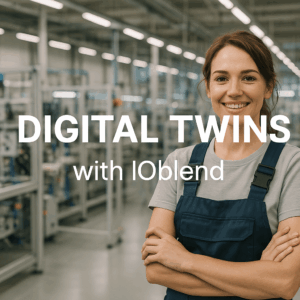IOblend and Streamsets are both advanced data integration platforms that cater to the growing needs of businesses, especially in real-time analytics use cases. While there are similarities, they also bring different features to the table. Here’s an overview of their capabilities:
Real-time Data Integration
IOblend:
- Supports real-time, production-grade data pipelines using Apache Spark with proprietary tech enhancements.
- Can integrate equally streaming (transactional event) and batch data due to its Kappa architecture with full CDC capabilities.
Streamsets:
- Designed to handle streaming data with native support for change data capture (CDC) and supports both real-time and batch processing.
Low-code/No-code Development
IOblend:
- Provides low-code/no-code development, facilitating quicker data migration and minimization of manual data wrangling.
Streamsets:
- Features a drag-and-drop interface for designing data pipelines and also supports scripting for more intricate requirements.
Data Architecture
IOblend:
- Enables delivery of both centralized and federated data architectures.
Streamsets:
- Offers a flexible architecture allowing for both centralized and decentralized data operations.
Performance & Scalability
IOblend:
- Boasts low-latency, massively parallelized data processing with speeds exceeding 10 million transactions per second.
Streamsets:
- Optimized for performance in large-scale environments and supports various scalability configurations to handle growing data loads.
Partnerships & Cloud Integration
IOblend:
- Has real-time integration capabilities with Snowflake, AWS, Google Cloud and Azure products and is an ISV technology partner with Snowflake and Microsoft.
Streamsets:
- Provides integration with major cloud platforms including AWS, Azure, Google Cloud, as well as other platforms and data stores.
User Interface & Design
IOblend:
- Consists of two main components: IOblend Designer and IOblend Engine, facilitating design and execution respectively.
Streamsets:
- Offers a singular, intuitive platform called Streamsets Data Collector, tailored for designing, deploying, and monitoring data pipelines.
Data Management & Governance
IOblend:
- Ensures data integrity with features like automatic record-level lineage, CDC, SCD, metadata management, de-duping, cataloguing, schema drifts, windowing, regressions, eventing, late-arriving data, etc. integrated in every data pipeline.
- Connects to any data source via ESB/API/JDBC/flat files, both batch and streaming (inc. JDBC) with CDC (supports all three log, trigger or query based).
Streamsets:
- Prioritizes data drift management, ensuring pipeline robustness against changes in data, infrastructure, and schemas. Also has strong monitoring capabilities.
- 100+ pre-built connectors to all major data sources
Cost & Licensing
IOblend:
- The Developer Edition is free, while the Enterprise Suite requires a paid annual license.
Streamsets:
- Offers a free community version and premium versions with added functionalities and support.
Deployment & Flexibility
IOblend:
- Operational on any cloud, on-premises, or in hybrid settings. Comes in Developer and Enterprise Editions.
Streamsets:
- Supports deployment in cloud, on-premises, and edge devices, ensuring flexibility in data operations.
Community & Support
IOblend:
- Being relatively new, its community is still burgeoning. Provides online support for Developer Edition and premium support for Enterprise Edition.
Streamsets:
- Sports a vibrant community providing resources, plugins, and assistance. Premium support is also available for enterprise-grade users.
To sum up, while IOblend places emphasis on real-time data integration and low-code solutions, Streamsets is tailored for handling streaming data with an emphasis on data drift management. Choosing between them would rest on the specific requirements, infrastructure, and objectives of an organization.

ERP Cloud Migration With Live Data Sync
Seamless Core System Migration: The Move of Large-Scale Banking and Insurance ERP Data to a Modern Cloud Architecture ⛅ Did you know that core system migrations in large financial institutions, which typically rely on manual data mapping and validation, often require parallel runs lasting over 18 months? The Core Challenge The migration of multi-terabyte ERP and

Legacy ERP Integration to Modern Data Fabric
Warehouse Automation Efficiency: Migrating and Integrating Legacy ERP Data into a Modern Big Data Ecosystem 📦 Did you know? Analysts estimate that warehouses leveraging robust, real-time data integration see inventory accuracy improvements of up to 99%. The Convergence of WMS and Big Data Data professionals in logistics face a profound challenge extracting mission-critical operational data such

Dynamic Pricing with Agentic AI
The Agentic Edge: Real-Time Dynamic Pricing through AI-Driven Cloud Data Integration 📊 Did You Know? The most sophisticated dynamic pricing systems can process and react to market signals in under 100 milliseconds. The Evolution of Value Optimisation Dynamic Pricing and Revenue Management (DPRM) is a complex computational science. At its core, DPRM aims to sell the right

Smarter Quality Control with Cloud + IOblend
Quality Control Reimagined: Cloud, the Fusion of Legacy Data and Vision AI 🏭 Did You Know? Over 80% of manufacturing and quality data is considered ‘dark’ inaccessible or siloed within legacy on-premises systems, dramatically hindering the deployment of real-time, predictive Quality Control (QC) systems like Vision AI. Quality Control Reimagined The core concept of modern quality

Predictive Aircraft Maintenance with Agentic AI
Predictive Aircraft Maintenance: Consolidating Data from Engine Sensors and MRO Systems 🛫 Did you know that leveraging Big Data analytics for predictive aircraft maintenance can reduce unscheduled aircraft downtime by up to 30% Predictive Maintenance: The Core Concept Predictive Maintenance (PdM) in aviation is the strategic shift from a time-based or reactive approach to an ‘as-needed’ model,

Digital Twin Evolution: Big Data & AI with
The Industrial Renaissance: How Agentic AI and Big Data Power the Self-Optimising Digital Twin 🏭 Did You Know? A fully realised industrial Digital Twin, underpinned by real-time data, has been proven to reduce unplanned production downtime by up to 20%. The Digital Twin Evolution The Digital Twin is a sophisticated, living, virtual counterpart of a physical production system. It
